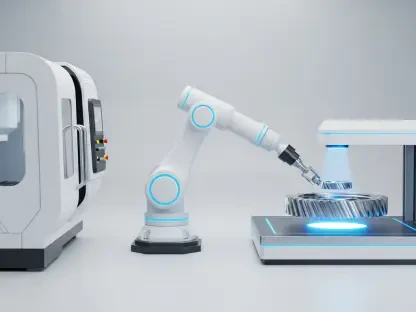Modern manufacturing is undergoing a revolution driven by the rapid development and adoption of emerging technologies. Advancements in AI, IoT, predictive maintenance, cloud computing, and collaborative innovation are collectively reshaping the industry. These innovations not only enhance operational efficiency but also promote sustainability and resilience in manufacturing processes. This article explores how these emerging technologies are transforming the manufacturing landscape.
The Convergence of AI and IoT
AIoT: Enhancing Operational Efficiency
Artificial Intelligence (AI) and the Internet of Things (IoT) are converging to form AIoT, a powerful combination that enables real-time data collection and analytics. By integrating AI with IoT devices, manufacturers can make quick, informed decisions to optimize factory operations. This technology drives digitalization, resulting in significant improvements in productivity and workplace safety. In the realm of manufacturing, AIoT is not just a buzzword but a transformative force that enhances operational efficiency in unprecedented ways.
The integration of AI with IoT devices allows for seamless automation of various processes within the factory setting. Machines equipped with IoT sensors continuously collect data from the production floor, feeding it into AI algorithms for rapid analysis. This feedback loop ensures that any inefficiencies or potential issues are promptly identified and addressed. Consequently, manufacturers experience fewer disruptions and can maintain a smoother production flow. This paradigm shift towards smarter, automated operations is proving indispensable for companies aiming to stay competitive in an evolving market.
Real-time Data and Analytics
AIoT allows for the continuous monitoring of manufacturing processes, providing valuable insights into equipment performance and production cycles. Real-time analytics empower manufacturers to anticipate potential issues, streamline workflows, and enhance overall efficiency. These advancements are instrumental in creating smart factories with advanced automation capabilities. Real-time data and analytics not only improve operational agility but also elevate the strategic decision-making process.
The ability to collect and analyze data in real-time means that manufacturers can implement just-in-time solutions to problems that arise. For instance, if a particular machine exhibits signs of wear or irregular performance, AIoT systems can alert maintenance teams before a complete breakdown occurs. This preemptive approach minimizes downtime and extends the lifespan of critical equipment. Over time, the data collected offers deeper insights into long-term trends and patterns, informing more strategic decisions on production planning, resource allocation, and process improvements. Manufacturers that adopt AIoT technologies are better positioned to optimize their operations, reduce costs, and maintain high-quality standards.
Predictive and Proactive Maintenance
Predictive Maintenance with AI
Predictive maintenance, powered by AI, is pivotal in reducing downtime and maintenance costs. By analyzing data from machinery and equipment, AI can accurately predict when maintenance is needed, thus preventing unexpected failures. This method is particularly essential for industrial robots, where operational continuity is crucial. The ability to forecast potential breakdowns significantly enhances the maintenance strategy, making it more effective and less disruptive.
For manufacturers heavily reliant on machinery and robotics, the stakes are high. Any unanticipated equipment failure can result in significant financial loss and operational setbacks. AI-assisted predictive maintenance mitigates these risks by identifying anomalies and alerting maintenance teams well before a failure occurs. This proactive approach not only extends the lifespan of machinery but also optimizes maintenance schedules, ensuring that servicing is performed only when necessary. The result is a more efficient, cost-effective maintenance regimen that supports continuous production and operational stability.
Proactive Approaches: Thermal Imaging and More
Beyond AI, other proactive maintenance techniques like thermal imaging are gaining traction. Infrared cameras detect heat anomalies in equipment, allowing preemptive action to address potential issues before they become critical. These proactive approaches ensure uninterrupted operations and extend the lifespan of machinery, contributing to cost savings and efficiency. Thermal imaging, in particular, is a powerful tool for identifying problems that are not immediately visible to the naked eye.
The application of thermal imaging in industrial settings allows maintenance teams to conduct non-invasive inspections, identifying hotspots and areas of abnormal temperature that may indicate underlying problems. By catching these issues early, companies can perform necessary repairs or adjustments without having to halt production lines. Other non-AI proactive techniques, such as vibration analysis and ultrasonic testing, also play crucial roles in detecting early signs of mechanical faults. Together, these methods form a comprehensive maintenance strategy that safeguards equipment health and boosts overall operational efficiency.
Achieving Digital Maturity and AI Integration
Challenges and Pathways to AI Maturity
The journey to achieving AI maturity is fraught with challenges, including supply chain dependencies and strict regulatory requirements. Manufacturers must navigate these obstacles to scale AI from pilot projects to full-scale implementations. Structured pathways emphasize resilience and agility, guiding manufacturers toward seamless AI integration. A critical aspect of this journey is recognizing and addressing the unique hurdles that each industry segment faces.
The transition from pilot projects to enterprise-wide AI adoption is often hampered by fragmented data systems and a lack of cohesive strategy. Manufacturers must invest in robust data infrastructure and cross-functional collaboration to successfully scale AI initiatives. Moreover, fostering a culture of innovation within the organization is essential for overcoming resistance to change. Training and upskilling the workforce to handle new technologies also play a significant role in the seamless integration of AI. By adopting a structured, strategic approach, manufacturers can overcome these challenges and fully realize the benefits of AI.
Industry-Specific Solutions for AI Adoption
Tailoring AI solutions to specific industry needs is crucial for successful adoption. Customizing AI applications ensures they address unique manufacturing challenges, fostering better results and smoother integration. This bespoke approach is essential for aligning AI capabilities with operational goals and regulatory compliance. Industry-specific AI solutions help manufacturers navigate the complexities of their operations while maximizing the technology’s potential.
For example, in the automotive sector, AI can optimize the supply chain by predicting demand fluctuations and adjusting inventory levels accordingly. In pharmaceutical manufacturing, AI can enhance quality control processes, ensuring that products meet stringent regulatory standards. Each industry has its unique set of challenges and requirements that off-the-shelf AI solutions may not fully address. By developing and implementing customized AI systems, manufacturers can achieve more precise and impactful outcomes, driving innovation and efficiency within their specific fields.
Decarbonization through Smart Technologies
Smart Building Technologies
Manufacturers are increasingly leveraging smart building technologies to achieve sustainability goals. These technologies optimize energy usage, reduce waste, and promote eco-friendly practices. Implementing advanced automation in areas like energy-efficient paint shops exemplifies how smart technologies can minimize environmental impact while boosting productivity. The integration of smart building systems in manufacturing facilities is a significant step towards achieving decarbonization.
Smart building technologies encompass a wide range of solutions, from automated lighting and HVAC systems to advanced energy management platforms. These systems work synergistically to reduce the overall energy footprint of manufacturing operations. For example, sensors can monitor occupancy levels and adjust lighting or climate controls in real-time, ensuring that energy is not wasted. Additionally, smart meters and energy analytics provide detailed insights into consumption patterns, enabling manufacturers to identify opportunities for further efficiency gains. The adoption of smart building technologies is a critical component of broader sustainability strategies, helping manufacturers meet regulatory requirements and corporate social responsibility goals.
Sustainable Manufacturing Practices
In pursuit of sustainability, manufacturers adopt practices that reduce carbon footprints and enhance resource efficiency. From repurposed robots to green energy solutions, these efforts align manufacturing operations with global environmental goals. Embracing sustainable practices is not just a trend but a necessity for future-proofing manufacturing processes. Sustainable manufacturing practices are increasingly becoming a cornerstone of modern industrial operations.
Implementing green energy solutions such as solar panels, wind turbines, and energy-efficient machinery can significantly reduce the environmental impact of manufacturing activities. Additionally, repurposing robots and machinery extends the lifecycle of existing assets, reducing the need for new resource-intensive production. Waste reduction and recycling programs further contribute to environmental sustainability. By adopting a holistic approach to sustainability, manufacturers not only enhance their operational efficiency but also improve their brand reputation and compliance with international environmental standards.
The Shift to Cloud-Based EDI
Cloud Solutions for Improved Collaboration
The transition to cloud-based Electronic Data Interchange (EDI) systems is critical for modern manufacturing. Traditional EDI systems, often rigid and less adaptable, are being replaced by more agile, accurate, and secure cloud solutions. These systems enhance collaboration, streamline processes, and improve data security, essential for contemporary manufacturing demands. The shift to cloud-based EDI marks a significant evolution in how manufacturers manage and exchange critical business information.
Cloud-based EDI solutions offer greater flexibility and scalability compared to their traditional counterparts. They enable real-time data exchange and seamless integration with other cloud-based applications, enhancing overall operational efficiency. Furthermore, cloud solutions provide robust security features, ensuring that sensitive information is protected from cyber threats. Enhanced collaboration tools within cloud-based EDI systems facilitate better communication and coordination between suppliers, manufacturers, and customers. This improved collaborative environment leads to more efficient supply chain management and faster response times to market demands.
Enhancing Efficiency with Cloud EDI
Cloud-based EDI solutions offer numerous benefits, including real-time data exchange, reduced errors, and greater scalability. Manufacturers can seamlessly integrate cloud EDI with existing systems, facilitating smoother operations and improved supply chain management. This shift is integral to maintaining competitiveness in the rapidly evolving manufacturing landscape. The adoption of cloud-based EDI solutions represents a strategic move towards enhanced operational agility and efficiency.
Traditional EDI systems often suffer from limitations such as slow processing speeds and complex setup requirements. In contrast, cloud-based EDI systems are designed for easy configuration and rapid deployment. This ease of implementation allows manufacturers to quickly adapt to changing business needs and market conditions. Moreover, cloud-based EDI systems can handle larger volumes of transactions and data, supporting the growth and expansion of manufacturing operations. By leveraging the advantages of cloud technology, manufacturers can achieve higher levels of efficiency, accuracy, and responsiveness in their supply chain processes.
Empowering Sales Teams with Advanced Tools
Salesforce Capabilities
Salesforce provides manufacturing sales teams with tools tailored to the industry’s specific needs. Enhancing Sales Cloud and Service Cloud with manufacturing-specific functionalities enables sales teams to navigate complex workflows effortlessly, improving customer relationships and sales outcomes. Automated processes also free up time for strategic activities. Salesforce’s capabilities extend beyond basic customer relationship management, offering a comprehensive suite of tools designed to elevate manufacturing sales operations.
Manufacturers often face unique challenges in managing sales processes, from complex pricing structures to long sales cycles. Salesforce addresses these challenges by providing advanced configurator tools, automated quote generation, and real-time inventory tracking. These features streamline the sales process, allowing teams to respond more quickly and accurately to customer inquiries. Additionally, integrated analytics provide valuable insights into sales performance and customer behavior, helping sales teams make data-driven decisions. By leveraging Salesforce’s advanced tools, manufacturers can enhance their sales strategies, improve customer satisfaction, and drive revenue growth.
ERP Solutions for Mid-Size Manufacturers
Enterprise Resource Planning (ERP) solutions play a crucial role in balancing cost efficiency and operational effectiveness for mid-size manufacturers. These systems offer comprehensive guidance and services, optimized for budget constraints while tackling significant operational challenges. Implementing ERP solutions helps mid-size manufacturers achieve their goals efficiently and effectively. ERP solutions are indispensable for managing the complexities of manufacturing operations.
Mid-size manufacturers often operate with limited resources compared to their larger counterparts, making cost-effective and efficient operations paramount. ERP systems consolidate various business processes, from inventory management to financial reporting, into a single integrated platform. This centralization enhances transparency and coordination across the organization, reducing redundancies and improving overall productivity. Moreover, modern ERP systems offer scalability, allowing mid-size manufacturers to grow and adapt their operations as needed. By adopting ERP solutions, mid-size manufacturers can streamline their processes, make informed decisions, and optimize their resource utilization.
Collaborative Innovation and Public-Private Partnerships
Academia and Industry Collaborations
The collaboration between academia and industry is a key driver of innovation in manufacturing. Initiatives like the NVIDIA AI Tech Community in Pittsburgh foster partnerships that accelerate technological advancements. Institutions like Carnegie Mellon University and the University of Pittsburgh contribute significantly to creating joint technology centers that propel public-private collaboration. These collaborations are instrumental in translating cutting-edge research into practical applications for the manufacturing sector.
Academic institutions bring a wealth of knowledge and research capabilities to the table, while industry partners provide real-world challenges and opportunities for practical implementation. This synergy results in the development of innovative solutions that address pressing manufacturing issues. By working closely with academia, manufacturers can access the latest technological advancements and research findings that can be directly applied to improve their operations. Collaborative innovation initiatives also provide valuable opportunities for students and researchers to engage with industry, fostering a pipeline of skilled talent equipped to tackle future manufacturing challenges.
Benefits of Public-Private Partnerships
The manufacturing industry is currently experiencing a significant transformation fueled by the swift development and implementation of groundbreaking technologies. Innovations in artificial intelligence (AI), the Internet of Things (IoT), predictive maintenance, cloud computing, and collaborative innovation are collectively revolutionizing the sector. These advancements are not only boosting operational efficiency and productivity but are also promoting sustainability and resilience within manufacturing processes. AI and IoT are enabling smart factories where interconnected machines communicate seamlessly, making real-time adjustments to improve efficiency. Predictive maintenance minimizes downtime by identifying potential issues before they lead to equipment failure, while cloud computing offers scalable solutions for data storage and processing, fostering greater collaboration and innovation. This holistic integration of advanced technologies is setting new benchmarks for manufacturing, ensuring the industry is prepared for future challenges and opportunities. This article delves into the various ways these emerging technologies are reshaping the manufacturing landscape, highlighting their impact on both the present and the future of the industry.









